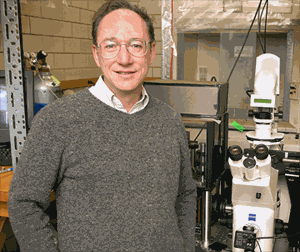There may be tiny bubbles in the wine, but not at the interface between water and a waxy coating on glass, according to a new study carried out at the Advanced Photon Source (APS).
The behavior of water when placed in contact with hydrophobic (water-repellent) surfaces, such as raincoats and freshly waxed cars, has puzzled scientists for a long time. According to a controversial theoretical prediction, water near a hydrophobic surface will pull away and leave a thin layer of depleted water at the surface – that is, water molecules at the interface will pack less tightly than usual.
Now, a team of researchers from the University of Illinois at Urbana-Champaign (UIUC) and Argonne has resolved the controversy. Using near-perfect hydrophobic surfaces and synchrotron x-ray measurement techniques at the XOR/BESSRC beamline 12-BM at the APS, the researchers found the theoretical prediction to be correct.
"Previous experiments have been interpreted sometimes in favor of a depletion layer, sometimes against, and sometimes as indicating intimate solid-water contact in places and 'nanobubbles' in others," said Steve Granick, a professor of materials science and engineering, chemistry and physics at Illinois.
"Part of our study was to help understand why there was so much disagreement in the scientific literature," said Granick, who also is a researcher at the Frederick Seitz Materials Research Laboratory on the UIUC campus and at the university’s Beckman Institute for Advanced Science and Technology.
To study the nature of hydrophobicity, the researchers first prepared a nearly ideal hydrophobic surface – a self-assembled methyl-terminated octadecylsilane monolayer. Then they made synchrotron x-ray measurements of the interface between water and monolayer.
The measurements revealed a depletion layer, about one water molecule in thickness. The depletion layer was present with and without air dissolved in the water. Because no nanobubbles were seen, bubbles must not play a significant role in hydrophobicity, the researchers conclude.
The synchrotron x-ray data "unambiguously confirm the theoretical expectation that water, when it meets a planar hydrophobic surface, forms a depletion layer," the researchers write.
"We found that in a real system – more complicated that the theory assumes – the theory does capture the essence," Granick said. "The next time I see water beading on a raincoat, my vision of how the water molecules experience that raincoat is going to be different."
The research team included University of Illinois graduate student and lead author Adelé Poynor, graduate student Liang Hong, physicist Ian Robinson (now at University College London); and synchrotron x-ray expert Paul A. Fenter and postdoctoral researcher Zhan Zhang, both at Argonne. — James E. Kloeppel, Physical Sciences Editor, University of Illinois
Contact: Steve Granick, call 217-333-5720; e-mail: sgranick@uiuc.edu.
See: Adelé Poynor, Liang Hong, Ian K. Robinson, Steve Granick, Zhan Zhang, and Paul A. Fenter; "How Water Meets a Hydrophobic Surface," Phys. Rev. Lett. 97, 266101 (2006); doi:10.1103/PhysRevLett.97.266101
The original version of this press release can be found here.
This work was supported by the U.S. Department of Energy through the Geosciences Research Program under Contract No. W-31-109-ENG-38 to Argonne National Laboratory, and by No. DEFG02-02ER46019 to the University of Illinois at Urbana-Champaign. Use of the Advanced Photon Source was supported by the U. S. Department of Energy, Office of Science, Office of Basic Energy Sciences, under Contract No. DE-AC02-06CH11357.
Argonne is a U.S. Department of Energy laboratory managed by UChicago Argonne, LLC

